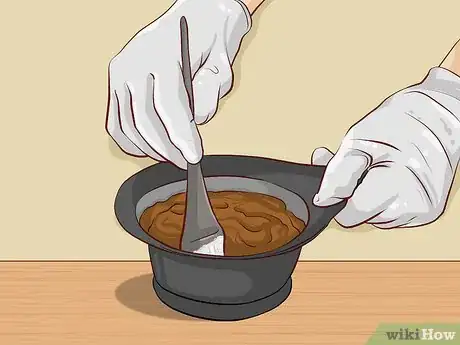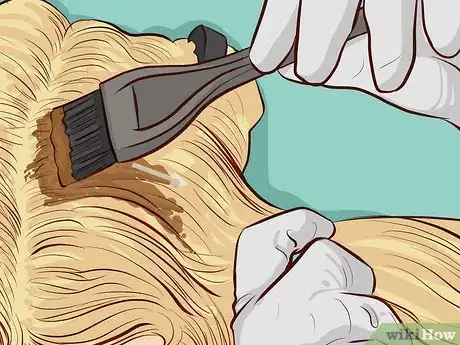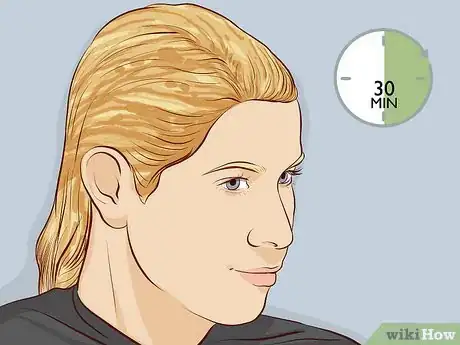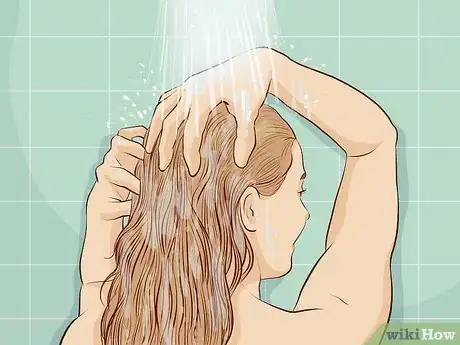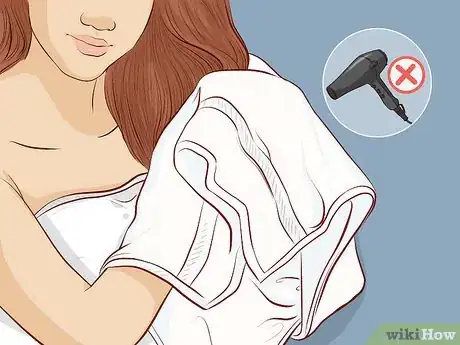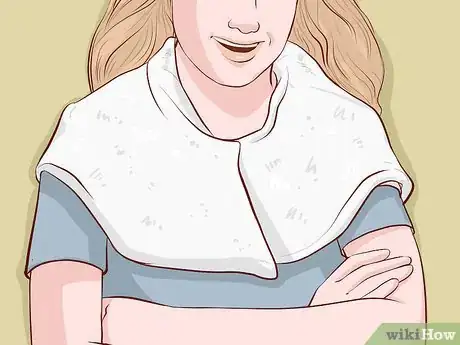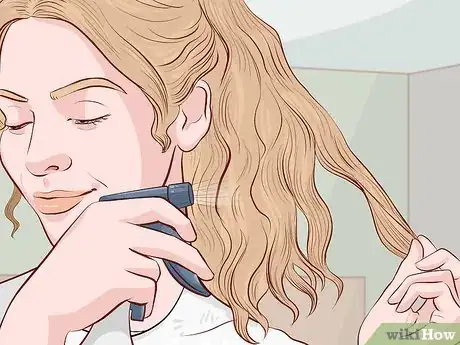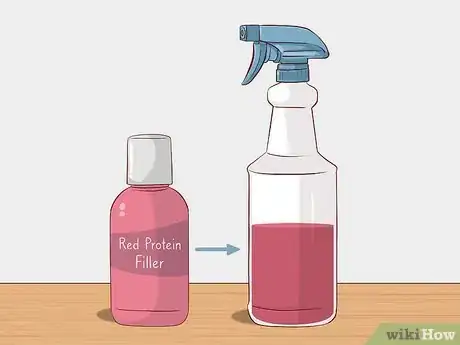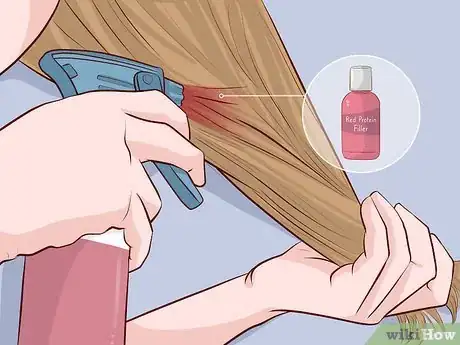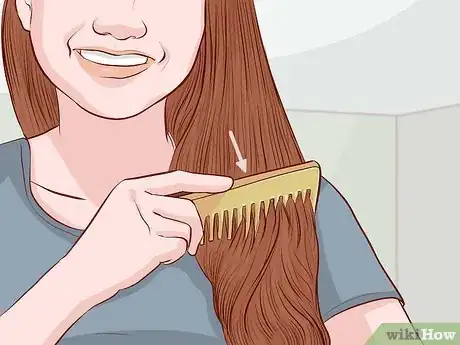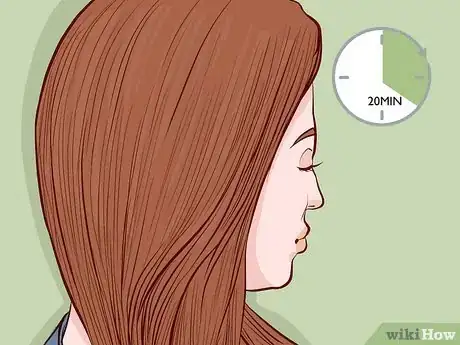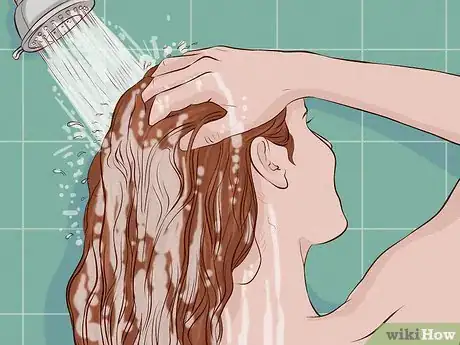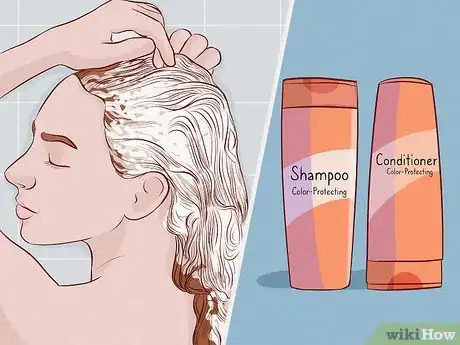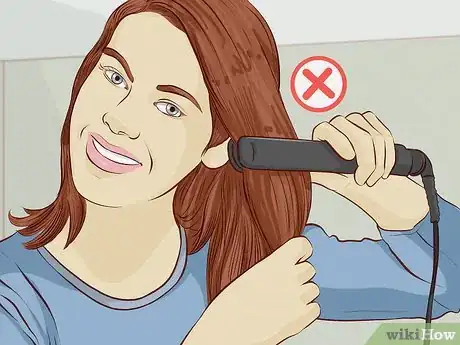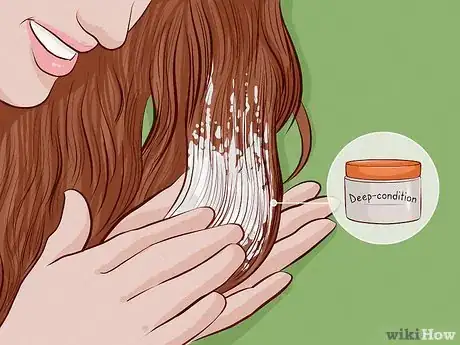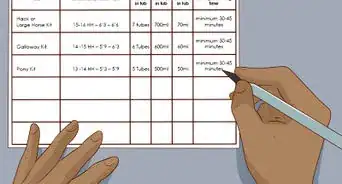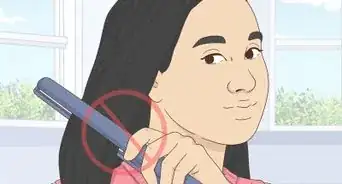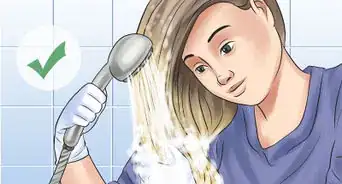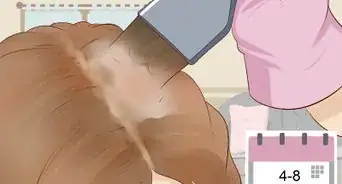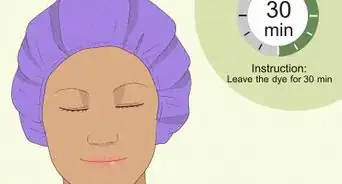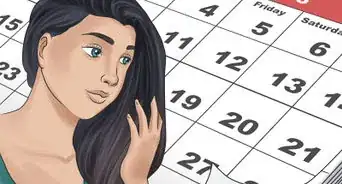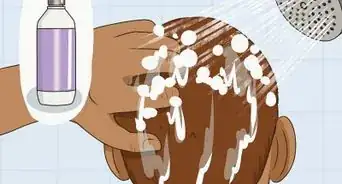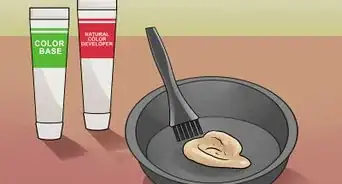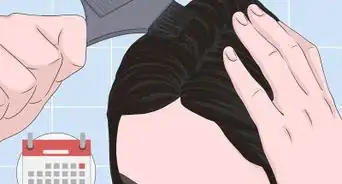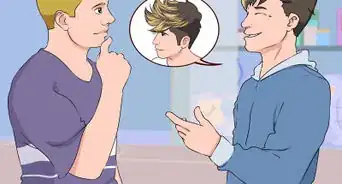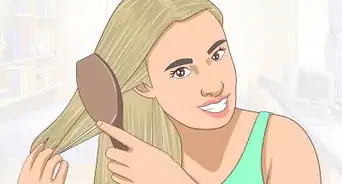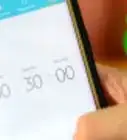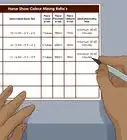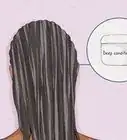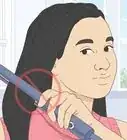This article was co-authored by Karen Leight. Karen Leight is a Professional Hair Stylist and the Owner of Karen Renee Hair, a private salon suite inside the Salon Republic Hollywood in Los Angeles, California. With over 12 years of experience, Karen is a licensed cosmetologist specializing in hair color, balayage technique, and women’s and men’s precision haircuts.
There are 14 references cited in this article, which can be found at the bottom of the page.
This article has been viewed 258,902 times.
Maybe you’ve bleached your hair to dye it a lighter brown, or maybe you’re just feeling done with the bleached look—whatever the reason, you’re ready for a change! Dyeing bleached hair back to brown isn't hard, but it does involve more steps than your average dye job since you'll need to add warm tones back into your hair. Don't worry though—below we'll walk you through everything you need to do to transform your hair step-by-step.
Steps
Dyeing Your Hair
-
1Choose a hair dye color that is 2-3 shades lighter than the color you want. Since bleached hair is more porous, even with the protein filler, it absorbs more color than healthy hair does and ended up looking much darker than the intended color.[1] You’ll want to choose a slightly lighter color to balance out this darkening effect.[2]
- If you’re buying based on the image on the front of the box, look for one that’s slightly lighter than what you want.[3]
-
2Protect your skin and clothes with gloves and an old towel. Before you even start mixing dye, put on a pair of latex gloves and lay an old towel around your shoulders to protect your clothes. The color will dye anything it touches, so make sure to wear old clothes that you aren’t worried about getting dirty.[4]
- Use a dark towel to hide any stains from the dye.
Advertisement -
3Mix and apply the brunette dye according to the box instructions. With an applicator brush and a plastic bowl, measure and mix the dye and developer included in the color kit. Generally, dye and developer should be mixed in a 1:1 ratio, but this can vary between manufacturers. Make sure to follow the instructions on the box and combine the products until they have a creamy consistency.[5]
- Some kits will also include a conditioning or moisturizing treatment.
-
4Divide your hair into 4 sections and clip them up. Using the pointed end of your applicator brush, part your hair down the middle, then from ear to ear. Clip each section up with a plastic clip to keep them out of the way while you work. Unclip and apply dye to only 1 section at a time.
-
5Apply the dye to your hair, working section by section. Unclip your first section, then load up your applicator brush with dye and paint it onto a thin layer of hair about .5 in (1.3 cm) thick. Start at the roots and paint the dye onto both sides to thoroughly coat the strands. Work your way through each section until all of your hair is coated.[6]
- Get as close as you can to the base of the roots without touching the scalp.
- If the color matches your natural roots, try to blend it into the roots so you don’t have to worry as much about grow-out. Color-matching can be very difficult, though, so unless you have a lot of experience with coloring your hair, you may want to just dye your whole head.[7]
-
6Let the dye process for the amount of time listed on the box. Most brunette dyes require 30 minutes to process, but always refer to the instructions. Check your hair’s progress every 5-10 minutes until the 30 minutes is up.
-
7Rinse out the dye with lukewarm water until the water runs clean. In a sink or shower, run water through your hair work your fingers through, rinsing out all of the excess dye. Check the water draining down to see if it still has a tint from the dye--when it has no tint, you’re done rinsing!
- After rinsing, apply a conditioner for color-treated hair, following the manufacturer’s directions. This will help seal in your color.
-
8Let your hair air-dry instead of blow-drying. Avoid using a blow dryer, since the heat can be too harsh on your freshly processed hair. Instead, pat your hair with a dark towel to remove excess water, then let it air-dry naturally
Adding Back Warm Undertones
-
1Choose a red protein filler to tint and strengthen the bleached hair.[8] Look for a filler with a strong red tint to add warm undertones back into bleached hair. This will help keep your hair from turning green or ashy when you dye it brown.[9] It also helps the dye adhere to your hair for smooth, even coverage.
- Color layering can be quite tricky, so if this is your first time using a tinted protein filler, you may want to consult with a professional colorist before you start.
-
2Wear old clothes and spread a towel over your shoulders. Although most color protein fillers are washable, you should shield your clothes as much as possible. Put on some old clothes that you don’t care about getting dirty or a hairdresser’s cape. Then wrap an old towel around your shoulders to block them from the spray.
- You should also put on a pair of latex gloves before you begin to avoid tinting your skin.
-
3Dampen your hair before your start using the filler. Fill a spray bottle with water and spray it throughout your hair until it’s lightly damp. Don’t soak it all the way through—just spray until your hair feels like you’ve just towel-dried it after a shower.[10]
-
4Pour the filler into a clean spray bottle and screw the top on. Since your hair is already damp, there’s no need to dilute the filler solution. Simply pour the solution straight into the spray bottle and cap it tightly.
- To avoid any contamination, make sure to use a clean spray bottle for the color protein filler.
-
5Spray the color protein filler all throughout your damp hair. With your latex gloves on, start spraying directly where the bleach begins on your hair. Work in sections, lifting and spraying pieces of hair until all of your bleached hair is thoroughly covered.[11]
- You only need to apply the filler to any bleached or dyed hair! Don’t worry about your natural roots, since they aren’t brittle or porous from being processed.[12]
-
6Comb through your hair with a wide-toothed comb. This will help evenly distribute the filler by pulling it through the strands. Start at your roots, or wherever the bleach begins, and gently drag the comb down to the ends of your hair. Once you’ve combed through all of your hair, rinse off the comb and let it dry.
- Make sure to use a plastic wide-toothed comb that you don’t mind getting filler on.
-
7Let the tinted filler sit for 20 minutes before you start dyeing. Set a timer and let the filler process for a full 20 minutes. Once the time is up, don’t rinse the filler out! It should stay in your hair until you finish dyeing and processing the brown dye.[13]
Caring for Processed Hair
-
1Avoid washing your hair for the first 48 hours after dyeing your hair. During this time, the dye will still be oxidizing and settling into your hair. Washing too soon can sometimes lift the color right off the hair, which you definitely want to avoid![14]
- This may mean skipping a workout or two in order to avoid the need to wash your hair.
- You can also wear a shower cap to keep your hair dry in the shower.
-
2Wash your hair every other day or less. Since washing can cause color fading, only wash every other day at most. You may even want to give your hair 3-4 days between washes, since it will likely be more dry after dyeing.[15]
- If your strands get greasy between washes, try using a dry shampoo.
-
3Use color-protecting shampoo and conditioner to wash your hair. These gentle, specially formulated products will help your color last longer and keep your hair healthy.[16] Look for ingredients that will moisturize and help remove product buildup without stripping color, such as keratin, natural plant oils, and minerals.[17]
-
4Avoid using hot styling tools while your hair is still fragile. Since your hair will be more vulnerable to damage after the chemical treatment, you’ll want to use as little heat on it as possible. This includes styling tools such as curling irons, straightening irons, and blow dryers.[18]
- If you have to use hot tools, make sure to spray on a heat protectant product first and use either the lowest heat or cool blast setting.
- You should especially avoid using hot styling tools in conjunction with heavy styling products, such as gels, volumizers, hairsprays, and mousses.
-
5Deep-condition your hair once a week to keep it moisturized. If your locks are still feeling brittle or dry, use a deep conditioning treatment or mask once a week. Work the product through your hair, concentrating on the tips, then run a wide-tooth comb through the strands to make sure it’s evenly distributed. Leave the mask on for 20 minutes (or as long as the product directs), then rinse well.[19]
- Look for a moisturizing mask that’s specifically formulated for colored hair.
- This is especially important if your hairstyling requires heat tools.
Expert Q&A
Did you know you can get expert answers for this article?
Unlock expert answers by supporting wikiHow
-
QuestionCan you dye bleached hair?
 Laura MartinLaura Martin is a Licensed Cosmetologist in Georgia. She has been a hair stylist since 2007 and a cosmetology teacher since 2013.
Laura MartinLaura Martin is a Licensed Cosmetologist in Georgia. She has been a hair stylist since 2007 and a cosmetology teacher since 2013.
Licensed Cosmetologist
-
QuestionCan toner darken bleached hair?
 Laura MartinLaura Martin is a Licensed Cosmetologist in Georgia. She has been a hair stylist since 2007 and a cosmetology teacher since 2013.
Laura MartinLaura Martin is a Licensed Cosmetologist in Georgia. She has been a hair stylist since 2007 and a cosmetology teacher since 2013.
Licensed Cosmetologist
-
QuestionWhat color can you dye your hair if it's black?
 Laura MartinLaura Martin is a Licensed Cosmetologist in Georgia. She has been a hair stylist since 2007 and a cosmetology teacher since 2013.
Laura MartinLaura Martin is a Licensed Cosmetologist in Georgia. She has been a hair stylist since 2007 and a cosmetology teacher since 2013.
Licensed Cosmetologist
Things You’ll Need
- Red tinted protein filler
- Plastic wide-tooth comb
- 2 spray bottles
- Brown dye
- Applicator brush
- Mixing bowl
- Plastic clips
- Dark towels
- Latex gloves
- Color-protecting shampoo and conditioner
- Deep-conditioning treatments
Warnings
- Since dyes and fillers contain chemicals, make sure to dye your hair in a room with proper ventilation, such as open windows and air circulation.⧼thumbs_response⧽
References
- ↑ Karen Leight. Professional Hair Stylist. Expert Interview. 13 November 2020.
- ↑ https://youtu.be/zf8zEpb1BiM?t=323
- ↑ http://www.instyle.com/hair/11-things-know-dyeing-your-own-hair#249769
- ↑ http://www.oprah.com/style/how-to-dye-hair-at-home
- ↑ https://bellatory.com/hair/How-to-dye-black-hair-brown
- ↑ https://bellatory.com/hair/How-to-dye-black-hair-brown
- ↑ http://www.goodhousekeeping.com/beauty/hair/g2754/haircolor-hacks-at-home/?slide=9
- ↑ Karen Leight. Professional Hair Stylist. Expert Interview. 13 November 2020.
- ↑ Karen Leight. Professional Hair Stylist. Expert Interview. 13 November 2020.
- ↑ https://youtu.be/zf8zEpb1BiM?t=40
- ↑ https://youtu.be/zf8zEpb1BiM?t=40
- ↑ https://youtu.be/mGP-3nf0biU?t=451
- ↑ https://youtu.be/zf8zEpb1BiM?t=40
- ↑ https://www.newbeauty.com/blog/dailybeauty/8723-things-you-shouldnt-do-after-coloring-your-hair/
- ↑ http://www.goodhousekeeping.com/beauty/hair/g2754/haircolor-hacks-at-home/?slide=14
- ↑ http://www.instyle.com/hair/11-things-know-dyeing-your-own-hair#249814
- ↑ http://www.goodhousekeeping.com/beauty/hair/g3878/best-shampoo-for-colored-hair/
- ↑ https://www.newbeauty.com/blog/dailybeauty/8723-things-you-shouldnt-do-after-coloring-your-hair/
- ↑ https://www.hairromance.com/2015/06/how-long-should-you-leave-hair-mask-on-your-hair.html
- ↑ https://youtu.be/zf8zEpb1BiM?t=158
- ↑ http://www.oprah.com/style/how-to-dye-hair-at-home
About This Article
If you want to dye your bleached hair brown, make sure to add in some warm undertones by applying a red protein filler first. This will help keep your hair from turning green or ashy when you dye it. When you pick a hair dye, opt for a color that's 2 to 3 shades lighter than what you want since bleached hair looks darker once it’s dyed. Before applying the dye, protect your skin with gloves and divide your hair into 4 sections with clips. Then, unclip 1 section and use the applicator brush to coat your hair with a layer of dye about ½ inch thick. Dye your hair section by section and give it the specified amount of time to process before rinsing out the remainder in the shower. For more help from our Cosmetology co-author, like how to care for your processed hair, read on!



